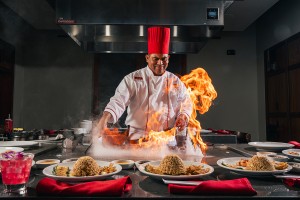Updated June 2025
Confused about hibachi vs teppanyaki? You’re not alone!
Many diners mix up these two popular Japanese cooking techniques. While both styles of cooking involve skilled chefs grilling food in front of guests, they offer completely different experiences. Let’s break down the key differences to help you choose the perfect dining experience.
Quick Answer: Hibachi vs Teppanyaki
Hibachi: Small portable grills with open grates, focuses on traditional grilling with minimal entertainment. Teppanyaki: Large flat iron griddles, combines cooking with theatrical chef performances.
What is Hibachi Cooking?
This grilling style dates back to Japan’s Heian period (794-1185 AD). The word “hibachi” means “fire bowl,” referring to the cylindrical containers originally designed to burn wood or charcoal.
Modern Features:
- Open-grate design perfect for larger cuts of meat
- Electric heating (instead of traditional charcoal) for indoor restaurant use
- Direct flame contact creates distinctive char flavors
- More intimate dining experience with subtle chef interaction
- Focus on authentic Japanese grilling techniques
Chefs often provide fun entertainment, like making onion ring volcanoes, but they focus on skilled grilling and natural flavors. Japanese steakhouses often feature this traditional grilling style, with popular hibachi food including grilled steak, chicken, and vegetables.
What is Teppanyaki?
This method combines “teppan” (iron plate) and “yaki” (grilled). While its exact origins are debated, most agree that modern Japanese teppanyaki was introduced to the U.S. by Japanese chefs seeking to create an interactive dining experience. Many teppanyaki restaurants showcase this Japanese style of cooking.
Key Features:
- Large flat iron griddles heated by propane flames
- Ideal for finely chopped ingredients, seafood, vegetables, and rice
- Theatrical dining with chef performances and tricks
- Guests sit around the cooking surface for full entertainment
- Interactive experience with chef-guest conversation and advanced cooking techniques
Key Differences Between These Cooking Styles
Cooking Surface
- Hibachi: Open grates allow direct flame contact and fat drainage
- Teppanyaki: Flat solid surface provides even heat distribution
Food Types
- Hibachi: Best for larger items like steaks, chicken thighs, whole vegetables
- Teppanyaki: Perfect for delicate seafood, diced vegetables, fried rice, eggs
Dining Experience
- Hibachi: Intimate atmosphere (4-8 guests)
- Teppanyaki: Entertaining, social experience (8-12 guests)
Entertainment Level
- Hibachi: Minimal performance, focus on cooking skill
- Teppanyaki: Full culinary theater with tricks and audience interaction
Which Should You Choose?
Choose traditional grilling if you prefer:
- Authentic Japanese dining experience
- Quieter, more intimate setting
- Smoky, charred flavors
- Smaller group gatherings
Choose the iron plate experience if you prefer:
- Interactive entertainment dining
- Culinary showmanship and chef tricks
- Social atmosphere for celebrations
- Versatile menu options cooked to order
Health Considerations
Both cooking methods offer healthy options. The open grates allow fat to drain naturally while the flat surface helps chefs use less oil.
This makes it easier to cook balanced meals with proteins and vegetables. Both approaches to Japanese barbeque emphasize fresh ingredients and skilled preparation.
Experience Both at Benihana
At Benihana, our skilled chefs master both traditional grilling techniques and spectacular teppanyaki performances. Whether you’re seeking authentic Japanese flavors or unforgettable entertainment, we offer the perfect culinary experience for any occasion.
